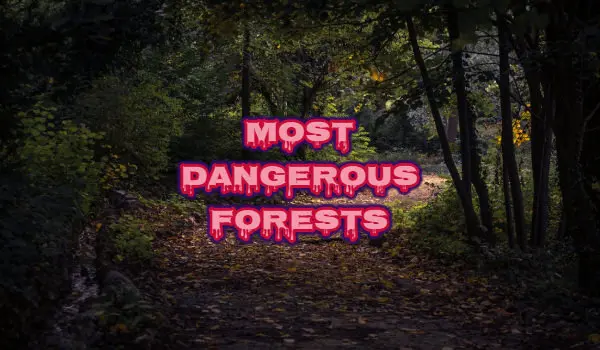Introduction to the Most Dangerous Forests in the World
Forests, typically associated with tranquility and natural beauty, can also harbor danger and intrigue. Certain forests around the world are known for their ominous reputations, whether due to extreme weather, challenging terrain, or the presence of hazardous wildlife. In this article, we explore the ten most dangerous forests in the world, each with its unique characteristics that make them perilous yet fascinating.
1. Aokigahara Forest (Japan)

Location: Honshu Island, Japan
Reason for Danger: Notorious suicide hotspot, dense foliage, complex terrain
Aokigahara Forest, also known as the “Sea of Trees,” is infamous for being a frequent site of suicides, making it one of the most eerie and unsettling places on Earth. The dense foliage and labyrinthine terrain contribute to a sense of isolation and disorientation for those who enter. Despite efforts to prevent suicides and promote awareness, Aokigahara remains a haunting and dangerous place.
2. Daintree Rainforest (Australia)
Location: Queensland, Australia
Reason for Danger: Dense vegetation, venomous creatures
While visually stunning, the Daintree Rainforest in Australia is home to numerous venomous creatures, including snakes, spiders, and stinging plants. Navigating through its dense vegetation can be challenging, and encounters with dangerous wildlife are a constant risk. Visitors must exercise caution and adhere to safety guidelines to avoid potential hazards.
3. Katyn Forest (Russia)
Location: Near Smolensk, Russia
Reason for Danger: Historical significance, presence of unexploded munitions
Katyn Forest gained infamy during World War II as the site where thousands of Polish officers were executed by Soviet forces. Today, the forest remains dangerous due to the presence of unexploded munitions and remnants of wartime activities. It serves as a solemn reminder of the region’s turbulent history and poses risks to those exploring its grounds.
4. Crooked Forest (Poland)

Location: West Pomerania, Poland
Reason for Danger: Mysterious and eerie atmosphere
The Crooked Forest in Poland is named for its unusual pine trees that grow with a sharp 90-degree bend at their base. The cause of this phenomenon remains a mystery, adding to the forest’s eerie and unsettling atmosphere. While not physically dangerous in the conventional sense, the forest’s mysterious allure and remote location contribute to its reputation as a place of intrigue and unease.
5. Hoia Baciu Forest (Romania)
Location: Cluj-Napoca, Romania
Reason for Danger: Paranormal activity, unexplained phenomena
Hoia Baciu Forest in Romania is often referred to as the “Bermuda Triangle of Transylvania” due to numerous reports of paranormal activity and unexplained phenomena. Visitors have reported experiencing nausea, anxiety, and unexplained scratches after entering the forest. While the dangers are more psychological than physical, the forest’s reputation continues to attract thrill-seekers and paranormal enthusiasts.

6. Black Forest (Germany)
Location: Southwest Germany
Reason for Danger: Dense woodland, challenging terrain
The Black Forest in Germany, known for its dense woodland and rugged terrain, presents challenges to hikers and explorers. Its name originates from the thick canopy that blocks out sunlight, creating an eerie ambiance. Navigating through its labyrinthine trails can be disorienting, and encounters with wildlife such as wild boars and wolves are possible. Proper preparation and respect for its natural surroundings are essential for safe exploration.
7. The Amazon Rainforest (South America)
Location: South America
Reason for Danger: Dense vegetation, venomous creatures, remote locations
The Amazon Rainforest, while renowned for its biodiversity and natural beauty, poses significant dangers to those who venture deep into its interior. Its dense vegetation can make navigation difficult, and encounters with venomous snakes, insects, and predators like jaguars are a constant risk. Additionally, its remote locations and harsh environmental conditions present challenges for rescue and medical assistance in case of emergencies.
8. Tsingy de Bemaraha (Madagascar)
Location: Madagascar
Reason for Danger: Razor-sharp limestone formations
Tsingy de Bemaraha in Madagascar is characterized by its spectacular limestone formations, which form a labyrinth of jagged peaks and deep crevices. The word “tsingy” translates to “where one cannot walk barefoot,” emphasizing the razor-sharp nature of the rocks. Navigating this terrain requires extreme caution to avoid injury, and the remoteness of the area complicates rescue efforts in case of accidents.
9. Yungas Road (Bolivia)
Location: Bolivia
Reason for Danger: Treacherous road through dense forest

Known as the “Death Road,” Yungas Road in Bolivia is infamous for its narrow lanes, precipitous drops, and treacherous conditions. Carved into the mountainside, the road winds through dense rainforest, with sheer cliffs on one side and a steep slope on the other. Accidents are common due to poor visibility, inclement weather, and the challenging terrain, making it one of the world’s most dangerous roads.
10. Taman Negara (Malaysia)
Location: Malaysia
Reason for Danger: Dense jungle, wildlife encounters
Taman Negara in Malaysia is one of the world’s oldest rainforests, renowned for its biodiversity and rugged terrain. Navigating through its dense jungle can be challenging, and encounters with dangerous wildlife such as snakes, tigers, and leopards are possible. The remote location and limited infrastructure add to the risks for visitors exploring this pristine but hazardous wilderness.
Conclusion
These ten forests around the world highlight the diverse and often surprising dangers that can be found in natural environments. From the psychological unease of Hoia Baciu Forest to the physical challenges of navigating Yungas Road, each forest presents unique risks that must be respected and prepared for. Whether due to natural hazards or historical significance, these dangerous forests continue to capture the imagination and curiosity of adventurers worldwide.
Understanding the risks associated with these forests is essential for safe exploration and appreciation of their natural beauty and cultural significance. By embracing caution and responsible behavior, visitors can experience the allure of these dangerous forests while minimizing potential dangers.
This article provides detailed information about each dangerous forest while incorporating SEO principles by focusing on relevant keywords and structured headings.
